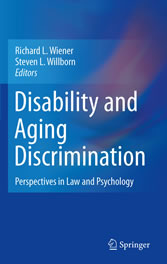Suchen und Finden
Acknowledgments
5
Contents
6
Contributors
8
1 Finding the Assumptions in the Law: Social Analytic Jurisprudence, Disability, and Aging Workers
10
Empirical Documentation of Existing Biases and Limitations
11
Age and the Workforce
11
Disability and the Workforce
14
The Role of Research in Policy Development
17
Application of Social Analytic Jurisprudence to Age Discrimination
19
Disparate Treatment of an Individual Claimant
19
Testing Assumptions of Intentional Age Discrimination
24
Disabilities and Reasonable Accommodations
30
Summary and Conclusion
37
References
37
Part I Aging and Discrimination
43
2 Ageism: The Strange Case of Prejudice Against the Older You
44
Mountains or Molehills
44
Planting the Seed of Ageism
45
History
45
Cultural Views
45
The Root of Ageism Is Fear of Death
46
Terror Management Theory
46
Ageism Is Institutionalized
47
Younger People Speak Differently to Elderly Persons
48
But Our Brains Cant Help Being Ageist
49
Helper, Heal Thy Self
50
Conclusion
51
References
52
3 Disability and Aging: Historical and Contemporary Views
55
Introduction
55
Defining Disability and the Civil War Pension Scheme
56
Disability and Aging, 150 Years Ago
59
Disability and Aging Today and Tomorrow
63
Employment and Attitudinal Discrimination
65
Today's Veterans of the Middle East Wars
67
Global Opportunities in Human and Economic Rights
69
Closing
71
References
71
4 The Aging Workforce and Paid Time Off
77
Work Interruption for Health-Related Personal and Family Care
79
The Aging Workforce and Worker Health
79
Health- and Care-Related Work Interruptions
80
Normative Arguments Favoring Intervention
81
Existing Protection Against Health- and Care-Related Work Interruption
83
Unpaid Benefits -- The Family and Medical Leave Act
83
Paid Benefits: Private
85
Paid Benefits: Public
86
Sick Leave
86
Short-Term Temporary Disability Insurance (TDI)
87
Social Preferences and Accommodation of Older Workers
88
References
94
5 Baby Boomers at Work: Growing Older and Working More
98
Legal Framework for Workplace Age Discrimination
99
Empirical Research and Implications for Workplace Age Discrimination
102
Societal Acceptability of Ageism
103
Procedural Fairness and the Self-Acceptance of Ageism
104
Legislation Against Age Discrimination Is Not the Answer
106
References
108
Part II Disability and Discrimination
111
6 The Relationship Between Disability DiscriminationINTnl; and Age Discrimination inINTtie;Workersx2019; Compensation
112
Workers Compensation Overview
112
Workers Compensation Developments in Recent Decades
113
Effects of These Developments on Cash Benefits
114
The Relationship Between Age and Three Important Variables: Health Status, Work Disability, and Sources of Medical Conditions
117
Health Status
117
Work Disability
117
Sources of Medical Conditions
118
The Link Between Disability Discrimination and Age Discrimination
121
Conclusions
122
References
123
7 The Stigma of Disabilities and the Americans with Disabilities Act
125
Introduction
125
The Stigma of Disabilities
127
The Legislative Paths
132
The Passage of the Rehabilitation Act
133
The Passage of the ADA
134
The Supreme Courts Interpretations
138
The Impact of the ADA
142
Cases
144
References
144
8 Age and Disability Within the Scope of American Discrimination Law
146
Comparing the Top Four
147
Thinking About the Intersection of Age and Disability
154
Conclusion
154
References
155
9 Implicit Attitudes and Discrimination Against People with Physical Disabilities
157
The Stigma of Physical Disability: Historical and Conceptual Background
158
Integrative Theoretical Frameworks
161
Ambivalent Attitudes
161
Dual Processes
165
Stigma, Disability, and Interactions: Re-examining the Literature
169
Nonverbal Behaviors
169
Verbal and Nonverbal Mismatches
171
Implications and Conclusions
173
References
176
10 Cross-Cultural Perspectives on Stigma
184
Stigma and Modern Day Issues
186
Aging
189
American Indian Notions of Elderly
190
Mental Illness
191
American Indians and Mental Illness
192
How to Integrate Divergent Stigma Perspectives Between Cultures Within the Law
195
References
197
11 Disability and Procedural Fairness in the Workplace
204
A Brief History
205
Procedural Justice and the ADA: Do Procedures Influence Satisfaction Beyond Accommodations
208
Potential Moderators of Procedural Fairness Effects
211
Research on Procedural Fairness and Beliefs About Deservingness
212
Deservingness Judgments in a Workplace Disability Context
215
Decision Makers Versus Decision Recipients: Role as a Moderator of Procedural Fairness Concerns
218
Role Effects in a Workplace Disability Context
221
Research on the Symbolic Consequences of Respect: In-Group Versus Out-Group Encounters
221
Ingroup Versus Outgroup Respect in a Disability Context
224
Summary
225
References
227
12 Procedural Justice and the Structure of the AgeINTnl; and Disability Laws
233
The Procedural Structure of the Age and Disability Laws
234
Groups and the Age and Disability Laws
237
Thinking About Procedures and Groups Under the ADEA and the ADA: Implications for Research on Procedural Justice
240
Voice
240
Decision Control
242
Group Value Theory
244
Conclusion
245
References
246
13 A Social Psychological Perspective of Disability Prejudice
247
Overview of the Current Work
248
When Might People Experience Disability Prejudice
249
What Does Disability Prejudice Look Like
253
Summary and Concluding Remarks
257
References
258
Index
261
Alle Preise verstehen sich inklusive der gesetzlichen MwSt.









